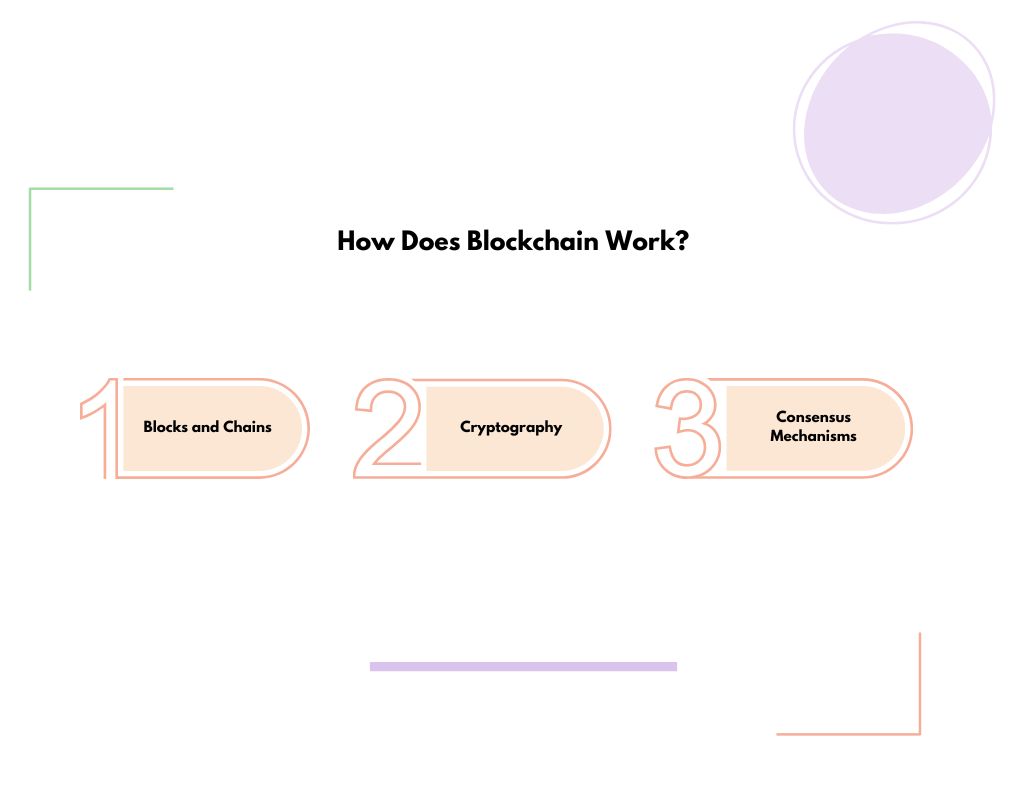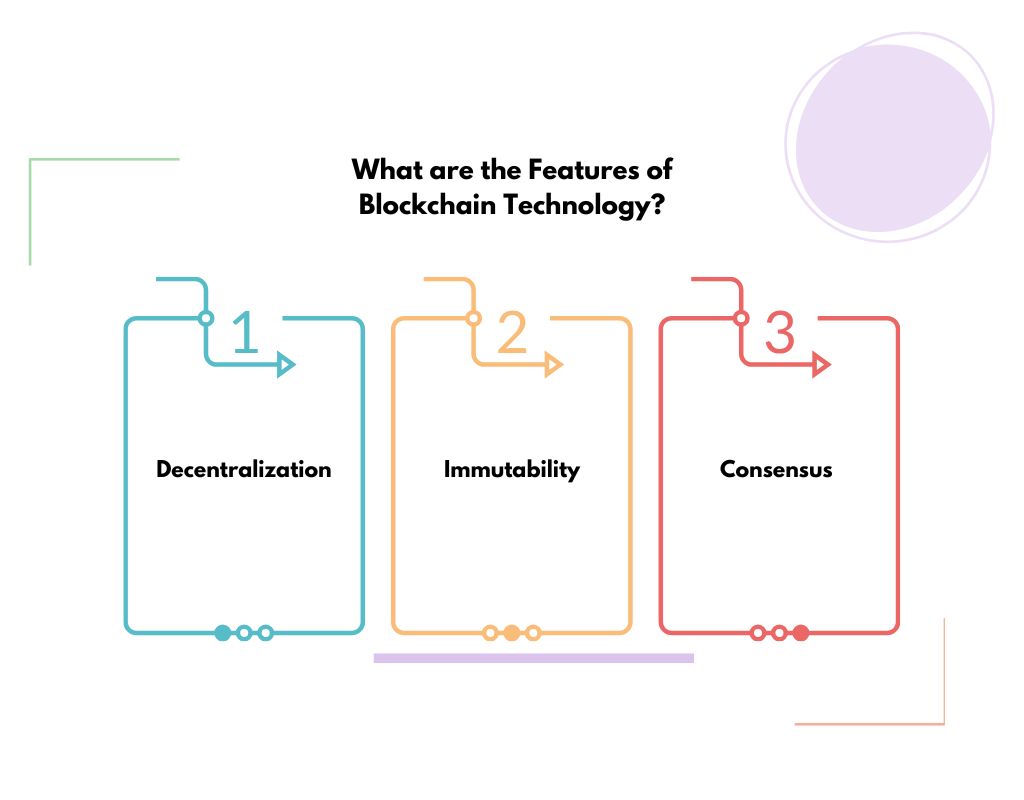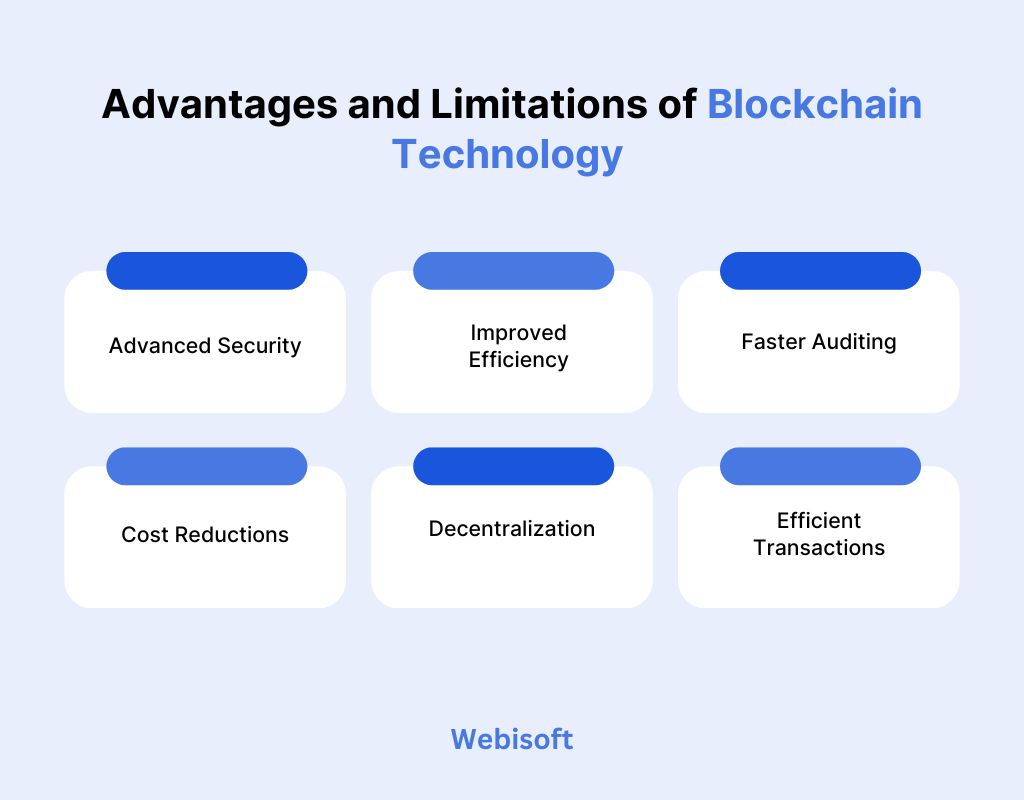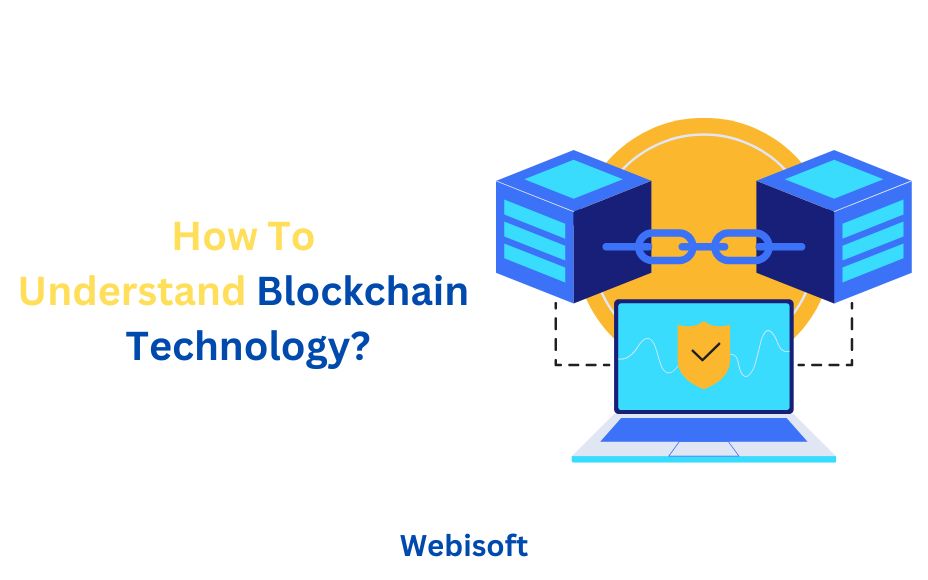Blockchain is more than hype, but most people struggle to understand what it actually does. Technical jargon, endless use cases, and misconceptions create confusion and doubt.
Blockchain is a decentralized digital ledger that offers trust, security, and automation—redefining how data is stored and verified.
This article walks you through how to understand blockchain technology, from its architecture to real-world applications that matter to your business or career.
Contents
- 1 What is Blockchain Technology?
- 2 How Does Blockchain Work?
- 3 What are the Features of Blockchain Technology?
- 4 Key Components of Blockchain Technology?
- 5 Types of Blockchain
- 6 Advantages and Limitations of Blockchain Technology
- 7 Drawbacks of Blockchains
- 8 What is Blockchain as a Service?
- 9 Bitcoin vs. Blockchain
- 10 Blockchain Usage In Different Industries
- 11 In Closing
- 12 Frequently Asked Questions
What is Blockchain Technology?
Blockchain technology is a decentralized and cryptographically secured method of recording data across multiple nodes. At its core, it functions as a distributed digital ledger, where transactions are logged in structured data blocks.
These blocks are chronologically linked, forming an immutable chain. Each block contains a timestamp, a unique cryptographic hash, and the hash of the previous block. This design ensures data integrity and prevents retroactive alterations.
Technical bodies such as the National Institute of Standards and Technology have detailed their architecture and security frameworks for enterprise-grade use.
How Does Blockchain Work?

At its core, blockchain is a decentralized system that records transactions across a network. It maintains transparency and trust without a central authority. Three foundational elements power its functionality include:
Blocks and Chains
Each transaction on a blockchain is grouped into a block. That block holds a set of verified data, a timestamp, and a unique identifier known as a cryptographic hash. It also stores the hash of the previous block, creating a permanent link.
This connection forms a sequential chain of blocks. Once a block is added, it becomes nearly impossible to modify any prior record. This structure ensures data immutability and enhances the integrity of distributed records in systems such as supply chain platforms.
Cryptography
Cryptography secures every transaction on the blockchain. It uses public key infrastructure (PKI) to enable identification and authentication without revealing private information. Each user has a public key and a private key to encrypt and decrypt data.
Digital signatures verify the sender’s identity and ensure that data remains untampered. These cryptographic processes are critical to confidentiality and trust in blockchain-based platforms, including health information exchanges and secure voting systems.
Consensus Mechanisms
A blockchain network reaches an agreement through a consensus mechanism. This process ensures that all nodes validate and agree on the state of the ledger before adding new data.
Popular methods include Proof of Work (PoW), Proof of Stake (PoS), and Practical Byzantine Fault Tolerance (PBFT).
Each method varies in efficiency, energy use, and risk tolerance. In public blockchain networks, PoW is common, while PoS is gaining ground for its reduced energy demand.
What are the Features of Blockchain Technology?

Blockchain technology operates on core principles that ensure data integrity, transparency, and trust. Among its defining features, decentralization, immutability, and consensus mechanisms stand out.
Decentralization
Decentralization removes the need for a central controlling entity. Instead, control is distributed across a network of nodes that store and validate identical data copies.
This minimizes single points of failure and enhances network resilience.
In public and private implementations, decentralized systems are more transparent and censorship-resistant.
It supports the importance of blockchain technology in sectors requiring operational trust and shared access, such as cross-border payments and land registry systems.
Immutability
Immutability ensures that once data is written to the blockchain, it cannot be changed. Each block links to the previous one via a secure cryptographic hash. Altering any data would invalidate the entire chain.
This property supports audit trails, fraud detection, and legal evidence management.
The feature is particularly vital in regulatory reporting, as recognized by standards from the Financial Action Task Force and government oversight bodies.
Consensus
Consensus mechanisms validate transactions across the network. These protocols allow multiple nodes to agree on the blockchain’s current state without relying on a central source of truth.
Mechanisms like Proof of Stake and Practical Byzantine Fault Tolerance prevent double-spending and unauthorized edits.
This strengthens trustless environments—a key factor in the benefits of blockchain technology for open financial systems and supply chain verification.
Key Components of Blockchain Technology?
The architecture of blockchain is built on several critical components that ensure its security, transparency, and automation.
A Distributed Ledger
A distributed ledger is a synchronized database shared across multiple nodes. Each participant maintains a copy, and any changes must be verified through a consensus mechanism. This setup prevents data manipulation and enhances transparency.
It eliminates centralized control and supports the working of blockchain in real-time transaction validation. Institutions like the World Bank recognize its value in anti-corruption frameworks and financial transparency tools.
Smart Contracts
Smart contracts are self-executing code stored on the blockchain. These scripts automatically trigger actions when specific conditions are met. They remove intermediaries, reduce costs, and speed up execution in complex workflows.
Smart contracts are critical in decentralized applications (dApps), particularly in insurance automation, cross-border trade, and intellectual property enforcement.
Their accuracy and traceability enhance the advantages of blockchain technology in contract-heavy industries.
Public Key Cryptography
Public key cryptography enables secure user identification and transaction validation. Every participant has a public key for receiving data and a private key for signing transactions. This dual-key structure forms the basis of data confidentiality and non-repudiation.
It ensures that only the intended recipient can access information. It also supports secure communication protocols aligned with standards from the National Institute of Standards and Technology.
Types of Blockchain
Blockchain systems are not one-size-fits-all. They differ in access control, governance, and scalability.
Public Blockchain Networks
Public blockchains are fully open and permissionless. Anyone can join the network, validate transactions, or create new blocks. Bitcoin and Ethereum are leading examples of this model.
They promote transparency and censorship resistance. However, public blockchains often face scalability and energy-efficiency challenges.
Their structure supports the working of blockchain in decentralized finance, identity systems, and open innovation ecosystems.
Private Blockchain Networks
Private blockchains are controlled by a single entity or organization. Access is restricted, and only verified participants can validate transactions or view records. These are commonly used in internal business operations.
Private chains offer higher speed and privacy but at the cost of decentralization.
They’re preferred in supply chain tracking, audit logs, and compliance-driven sectors where data access control is critical.
Hybrid Blockchain Networks
Hybrid blockchains combine elements of both public and private networks. A company can use a private blockchain for internal processes while linking selected data to a public chain for verification.
This model balances transparency with confidentiality.
It’s particularly useful in healthcare systems, government services, and inter-agency data coordination. Here, selective disclosure is required without compromising blockchain technology advantages.
Consortium Blockchain Networks
Consortium blockchains are governed by a group of organizations instead of one. These semi-decentralized models allow multiple stakeholders to operate a shared platform with joint governance.
They support trusted collaboration between entities like banks or logistics providers.
Use cases include interbank settlements, customs clearance, and cross-border compliance as supported by the World Economic Forum’s blockchain toolkit.
Advantages and Limitations of Blockchain Technology

Blockchain technology offers significant improvements in data security, operational efficiency, and system transparency. However, like any emerging technology, it comes with trade-offs.
Advanced Security
Blockchain’s use of public key cryptography, cryptographic hashing, and consensus algorithms makes it highly secure against tampering and unauthorized access.
Each transaction is time-stamped and verifiable, reducing fraud risk.
This architecture is especially important in financial networks and government registries, where data integrity is non-negotiable. Security is further enhanced through multi-party validation and immutable storage.
Improved Efficiency
By eliminating intermediaries and automating verification steps, blockchain streamlines processes across industries. It enables near real-time reconciliation of data between parties, reducing manual labor and paperwork.
In sectors like global trade and asset tracking, blockchain reduces redundancy, shortens processing time, and improves coordination.
Faster Auditing
Blockchain keeps a tamper-proof, chronological record of all activity. This allows auditors to trace transactions without delays or manual backtracking. Data is accessible in real-time and permanently archived.
This supports regulatory compliance, especially in finance and pharmaceuticals. Public institutions.
Cost Reductions
Blockchain lowers costs by automating transactions, reducing human error, and cutting third-party fees. Smart contracts further minimize legal and administrative expenses.
This is most impactful in cross-border settlements, insurance claims, and procurement systems.
As processes become leaner, organizations report direct savings and improved cost predictability—demonstrating clear blockchain technology advantages at scale.
Decentralization
Decentralization removes single points of control, making systems more resilient to failures and cyber threats. Every participant shares responsibility for maintaining and validating the ledger.
This design supports network transparency and aligns with democratic governance models.
It’s particularly relevant in projects focused on public service delivery and civic participation, where trust and accountability are essential.
Efficient Transactions
Transactions on blockchain are peer-to-peer, reducing settlement times from days to minutes. Combined with consensus mechanisms, this creates trust without needing central authorities.
Industries like energy trading, peer-to-peer lending, and digital asset exchanges benefit from this speed.
The working of blockchain in these areas improves liquidity, reduces disputes, and promotes seamless interactions.
Drawbacks of Blockchains
Despite its strengths, blockchain technology has critical limitations that can hinder adoption. These challenges include high implementation costs, data inefficiencies, legal ambiguity, and regulatory hurdles.
Technology Cost
Developing and maintaining a blockchain infrastructure requires substantial investment. Costs include setting up consensus mechanisms, securing the network, and maintaining computational power.
Speed and Data Inefficiency
Blockchains, especially public ones, are slower than centralized systems. Transaction throughput is often limited by consensus processes and block size.
Illegal Activity
The pseudonymous nature of blockchain can be exploited for illegal use. Without strong identity verification, it becomes harder to trace transactions linked to money laundering, fraud, or illicit trade.
Agencies like Europol and the FATF have raised concerns about the misuse of decentralized platforms.
Regulation
Blockchain operates in a fragmented legal landscape. Different countries enforce different rules, creating compliance challenges for cross-border services.
The lack of unified frameworks impacts adoption in financial services, healthcare, and data privacy.
Data Storage
Blockchain isn’t designed for handling large volumes of data. Every node replicates the full ledger, increasing the storage burden as networks scale.
This model creates tension between transparency and performance.
What is Blockchain as a Service?
Blockchain as a Service (BaaS) is a cloud-based solution that allows businesses to build, host, and manage blockchain applications without developing the infrastructure from scratch.
Major cloud providers offer these platforms with pre-configured tools and frameworks.
BaaS supports smart contract deployment, network management, and integration with enterprise systems.
It simplifies access to blockchain technology for organizations lacking in-house expertise. Use cases include supply chain monitoring, digital identity, and secure data sharing.
By outsourcing backend operations, firms can focus on application logic and user experience.
This model aligns with trends in as-a-service platforms adopted across industries. Several providers follow technical standards from the National Institute of Standards and Technology and ISO committees.
Bitcoin vs. Blockchain
Bitcoin and blockchain are often confused, but they serve different purposes. Blockchain is the underlying technology, while Bitcoin is one of its most well-known applications.
| Factor | Blockchain | Bitcoin |
| Definition | A decentralized digital ledger that records and secures data across a network of computers. | A cryptocurrency that uses blockchain to record and verify peer-to-peer financial transactions. |
| Purpose | Designed to store any type of data transparently and securely—used across industries. | Created specifically as a digital currency to bypass traditional banking systems. |
| Use Cases | Applied in supply chains, identity systems, healthcare, finance, and public records. | Used primarily for financial transactions, investment, and decentralized payments. |
| Governance Model | Can be public, private, hybrid, or consortium depending on the use case. | Maintained by a decentralized network of miners using Proof of Work. |
| Development Flexibility | Developers can build custom solutions tailored to regulatory or business needs using various consensus models. | Fixed protocol, limited flexibility—changes require community-wide consensus and are often slow to implement. |
Blockchain Usage In Different Industries
Blockchain adoption spans industries that demand trust, transparency, and data integrity.
- Banking and Finance: Used for real-time settlements, fraud detection, and compliance. Enhances transparency and lowers transaction costs in cross-border banking systems.
- Currency: Supports digital currencies by securing transactions, preventing double-spending, and enabling peer-to-peer financial networks without centralized intermediaries.
- Healthcare: Secures electronic medical records, ensures traceability of pharmaceuticals, and supports data sharing between authorized providers in compliance with health data standards.
- Property Records: Improves land registry accuracy and prevents fraud through immutable transaction logs tied to ownership and title verification processes.
- Cybersecurity: Protects sensitive data using cryptographic frameworks, access control layers, and decentralized identity verification for secure system architecture.
- Logistics: Enables real-time supply chain tracking, inventory monitoring, and verification of goods origin to ensure integrity and reduce counterfeiting.
- NFTs: Provides proof of ownership for digital assets. Blockchain guarantees authenticity, transferability, and scarcity for NFTs across art, gaming, and entertainment sectors.
- Insurance: Automates claims processing through smart contracts and enhances fraud prevention with auditable policy records and time-stamped transactions.
In Closing
Blockchain is no longer a future concept—it’s a practical tool transforming how businesses manage trust, security, and data. Its decentralized model offers strategic advantages in operations where transparency and integrity are non-negotiable.
For organizations ready to build blockchain-driven systems with measurable outcomes, Webisoft offers deep technical experience in custom blockchain development, smart contracts, and scalable infrastructure.
Their team works closely with you to architect and deploy real-world solutions—built for your industry’s demands.
Frequently Asked Questions
Is blockchain the same as a database?
No. A database is typically centralized and editable, while blockchain is decentralized, append-only, and tamper-resistant. It records data in chronological blocks across a distributed network.
Can blockchain be used without cryptocurrency?
Yes. Many enterprise blockchains function without a native token. These are used for supply chain tracking, identity verification, or secure recordkeeping, without involving any form of digital currency.
What industries are adopting blockchain the fastest?
Finance, logistics, healthcare, and real estate are leading blockchain adoption due to their need for data transparency, fraud prevention, and secure, verifiable transactions across stakeholders.
Is blockchain secure against cyberattacks?
Yes, blockchain uses cryptographic techniques and decentralized validation to prevent tampering. However, vulnerabilities can exist in external applications or smart contracts if not properly audited and secured.
How does blockchain handle privacy?
Public blockchains are transparent but pseudonymous. For sensitive data, private or hybrid chains with access controls and encryption are used to balance privacy and transparency.
